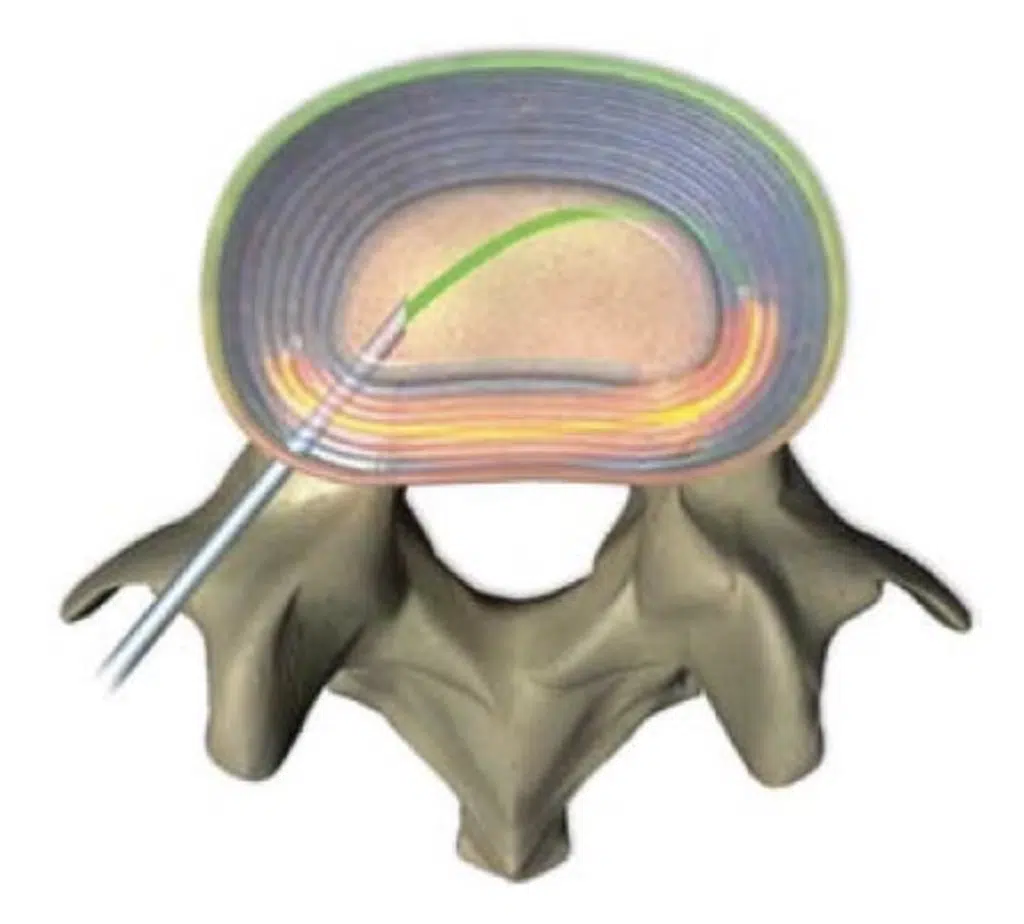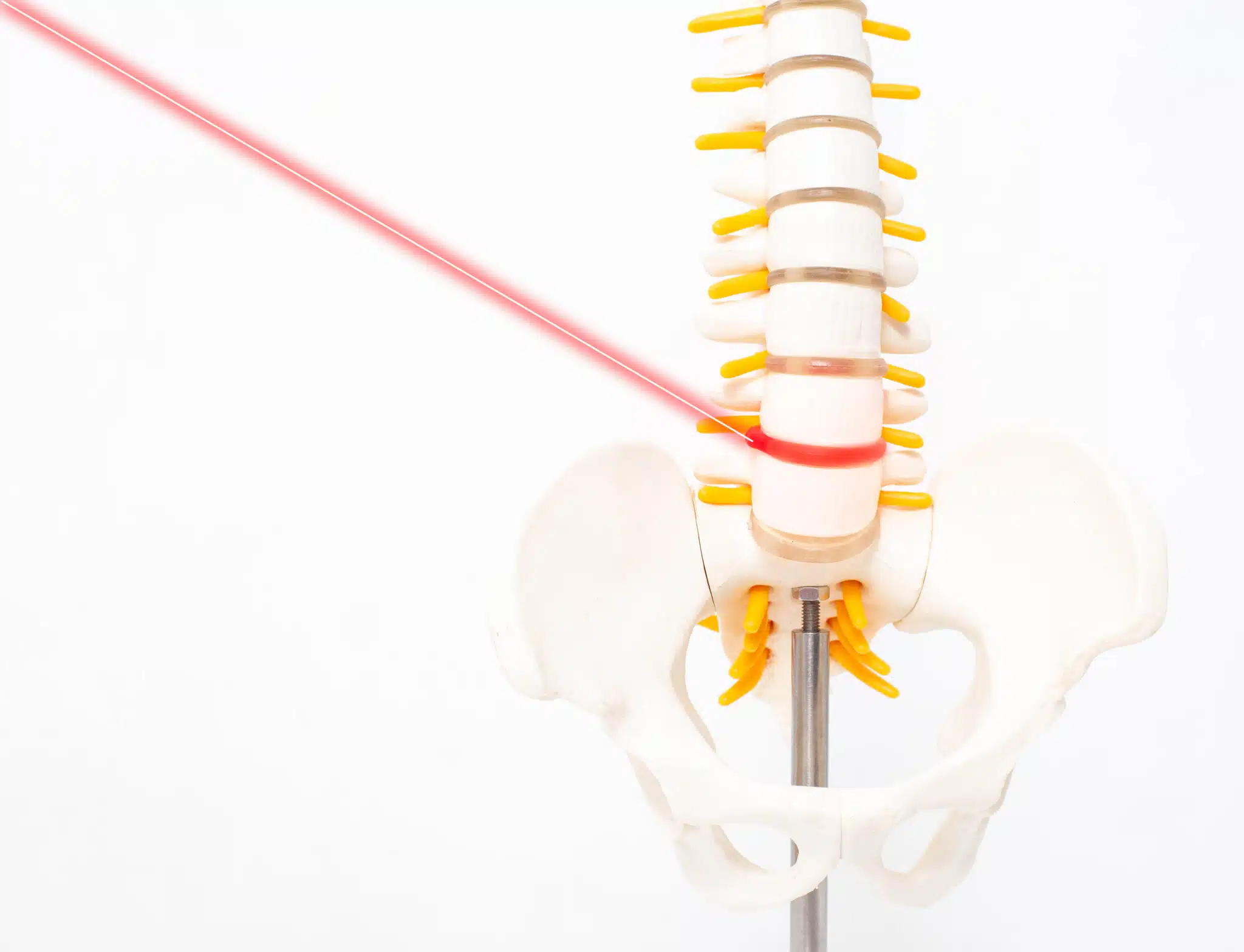Intradiscal electrothermal therapy (IDET) is a minimally invasive procedure that is used to treat low back pain caused by problems with the spinal discs. It involves inserting a thin electrode into the affected disc through a small incision in the skin, which is then heated using radiofrequency energy.
The heat is intended to cause the collagen fibers in the disc to contract, which can reduce the size of any tears or fissures in the disc and improve the disc’s ability to function properly. The heat also causes the destruction of nerve fibers which reduces the transmission of pain signals.
The procedure is usually performed on an outpatient basis, and patients typically go home the same day. After the procedure, patients may need to take pain medications for a short period of time, but most are able to resume their normal activities within a few days.
Intradiscal electrothermal therapy may also be referred to as intradiscal electrothermal annuloplasty (IDEA), thermal annuloplasty, intradiscal thermal therapy, or radiofrequency discal nucleoplasty (RFN)
How does Intradiscal Electrothermal Therapy (IDET) work?
During the IDET procedure, a thin electrode is inserted into the affected disc through a small incision in the skin, guided by fluoroscopy (a type of X-ray imaging). The electrode is then heated using radiofrequency energy, which generates heat within the disc.

The heat generated by the electrode helps to denature the protein in the disc, causing it to contract and thicken. This process, called collagen shrinkage, is believed to help seal any tears or cracks in the outer layer of the disc, reducing the pressure on the surrounding nerves and tissues and alleviating the pain.
In addition to causing collagen shrinkage, the heat generated by the electrode may also stimulate the growth of new collagen fibers in the disc, which can help to further stabilize the disc and reduce the risk of future herniation or degeneration.
Finally, the heat causes the nerves within the disc to be destroyed, which helps to reduce the pain that is being experienced.
Which conditions are treated with IDET?
Intradiscal Electrothermal Therapy (IDET) is primarily used to treat chronic low back pain caused by discogenic pain, which is pain that originates from the discs in the spine.
IDET is most commonly used to treat two types of disc-related conditions:
- Degenerative disc disease: Degenerative disc disease is a condition that occurs when the spinal discs lose water and elasticity over time, leading to thinning and weakening of the disc. This can cause breaks and fissures in the disc, causing chronic pain. IDET can be used to treat degenerative disc disease by heating the disc and triggering a healing response that strengthens and thickens the disc.
- Herniated discs: A herniated disc occurs when the soft, gel-like center of a spinal disc ruptures through a tear in the outer layer of the disc. This can put pressure on the nearby nerves, causing pain, numbness, or weakness in the back, buttocks, legs, or feet. IDET can be used to treat herniated discs by shrinking and sealing any tears in the outer layer of the disc, reducing pressure on the nerves.
What to expect during the procedure
Intradiscal Electrothermal Therapy (IDET) is a minimally invasive procedure that is typically performed on an outpatient basis. Here is a general overview of what you can expect during an IDET procedure:
- Preparation: Before the procedure, you will be asked to change into a hospital gown and lie down on a table. The area where the catheter will be inserted will be cleaned and numbed with a local anesthetic.
- Insertion of the catheter: Once the area is numbed, a small needle will be inserted into the disc under x-ray guidance. A small catheter will then be inserted through the needle and positioned within the disc.
- Heating the disc: Once the catheter is in position, it will be heated using radiofrequency energy. The heat will cause the proteins in the disc to denature, which will cause the disc to shrink and seal any small tears or fissures.
- Monitoring: During the procedure, your doctor will monitor your vital signs and the temperature within the disc to ensure that the heat is being applied evenly and that the catheter is not causing any damage to surrounding tissues.
- Removal of the catheter: Once the procedure is complete, the catheter will be removed and a small bandage will be placed over the insertion site.
- Recovery: You will be monitored for a short period of time after the procedure to ensure that there are no immediate complications. You will typically be able to go home the same day, but you may need to arrange for someone else to drive you.
After the procedure, you may experience some mild discomfort at the insertion site and in the back, but this can typically be managed with over-the-counter pain medications.
How long does the procedure take?
In general, the procedure typically takes between 30 minutes to an hour to complete.
However, the duration of an Intradiscal Electrothermal Therapy (IDET) procedure can vary depending on the number of discs being treated and other factors specific to each individual case.
When can I return to work and resume normal activities?
Depending on the type of work you do, you may be able to return to work within a few days of the procedure. However, if your job involves heavy lifting or other physical activities, your doctor may recommend that you take a few days or even a week off to allow your back to fully recover.
You will need to avoid any strenuous activities, such as heavy lifting or high-impact exercise, for several weeks after the procedure. Your doctor may recommend that you start with gentle exercises and gradually increase your activity level as your back heals.
How long does it take for IDET to start working?
In some cases, you may experience some initial relief from your symptoms soon after the procedure, but it’s important to keep in mind that the full effects of the procedure may not be felt until several weeks or even months after the procedure.
What are the risks of IDET?
As with any medical procedure, there are potential risks and complications associated with Intradiscal Electrothermal Therapy (IDET). Some of the possible risks of IDET may include:
- Nerve damage: The heat generated during the procedure can potentially damage nerves in the surrounding tissues, leading to pain or other complications.
- Infection: As with any procedure that involves breaking the skin, there is a risk of infection at the site of the procedure.
- Bleeding: There is a small risk of bleeding during or after the procedure, particularly if you are taking blood-thinning medications or have a bleeding disorder.
- Disc herniation: There is a small risk that the heat generated during the procedure may cause a herniation of the disc, which can lead to additional pain and complications.
Is Intradiscal Electrothermal Therapy right for me?
Determining whether or not Intradiscal Electrothermal Therapy (IDET) is right for you depends on several factors, including the underlying cause of your back pain, the severity of your symptoms, and your overall health and medical history.
If you are considering IDET as a treatment option, it’s important to discuss your individual case with your doctor or healthcare provider. They can help you determine if IDET is the right choice for your specific needs and goals and can provide you with information on other treatment options that may be appropriate for your condition.
